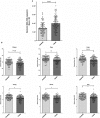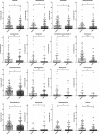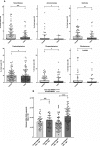Blood Microbiota Modification After Myocardial Infarction Depends Upon Low-Density Lipoprotein Cholesterol Levels
- PMID: 31566105
- PMCID: PMC6806051
- DOI: 10.1161/JAHA.118.011797
Blood Microbiota Modification After Myocardial Infarction Depends Upon Low-Density Lipoprotein Cholesterol Levels
Abstract
Background The role of bacteria on the onset of cardiovascular disease has been suggested. Reciprocally, increased intestinal bacterial translocation and bloodstream infection are common comorbidities associated with heart failure and myocardial infarction (MI). In this context, the aim of this study was to analyze the blood microbiome in patients shortly after acute myocardial infarction. Methods and Results We carried out a case control study comparing 103 patients at high cardiovascular risk but free of coronary disease and 99 patients who had an MI. The blood microbiome was analyzed both quantitatively by 16S quantitative polymerase chain reaction and qualitatively by 16S targeted metagenomic sequencing specifically optimized for blood samples. A significant increase in blood bacterial 16S rDNA concentration was observed in patients admitted for MI. This increase in blood bacterial DNA concentration was independent of post-MI left ventricular function and was more marked in patients with low-density lipoprotein cholesterol ≥1 g/L. In addition, differences in the proportion of numerous bacterial taxa in blood were significantly modified with the onset of MI, thus defining a blood microbiota signature of MI. Among the bacterial taxa whose proportions are decreased in patients with MI, at least 6 are known to include species able to metabolize cholesterol. Conclusions These results could provide the basis for the identification of blood microbiome-based biomarkers for the stratification of MI patients. Furthermore, these findings should provide insight into the mechanism underlying the negative correlation reported between low-density lipoprotein cholesterol concentration and the prognosis at the acute onset of MI and mortality. Clinical Trial Registration URL: http://www.clinicaltrials.gov. Unique identifier: NCT02405468.
Keywords: bacteria; blood metagenomics; blood microbiota; cholesterol; myocardial infarction.
Figures




Similar articles
-
Insights into the blood, gut, and oral microbiomes in Chinese patients with myocardial infarction: a case-control study.BMC Microbiol. 2025 Apr 19;25(1):226. doi: 10.1186/s12866-025-03878-9. BMC Microbiol. 2025. PMID: 40253360 Free PMC article.
-
Distinct blood and oral microbiome profiles reveal altered microbial composition and functional pathways in myocardial infarction patients.Front Cell Infect Microbiol. 2025 Apr 14;15:1506382. doi: 10.3389/fcimb.2025.1506382. eCollection 2025. Front Cell Infect Microbiol. 2025. PMID: 40297611 Free PMC article.
-
Exploring blood microbial communities and their influence on human cardiovascular disease.J Clin Lab Anal. 2022 Apr;36(4):e24354. doi: 10.1002/jcla.24354. Epub 2022 Mar 15. J Clin Lab Anal. 2022. PMID: 35293034 Free PMC article. Review.
-
Elevated Serum Non-HDL (High-Density Lipoprotein) Cholesterol and Triglyceride Levels as Residual Risks for Myocardial Infarction Recurrence Under Statin Treatment.Arterioscler Thromb Vasc Biol. 2019 May;39(5):934-944. doi: 10.1161/ATVBAHA.119.312336. Arterioscler Thromb Vasc Biol. 2019. PMID: 30866657
-
Triglyceride-Rich Lipoprotein Cholesterol and Risk of Cardiovascular Events Among Patients Receiving Statin Therapy in the TNT Trial.Circulation. 2018 Aug 21;138(8):770-781. doi: 10.1161/CIRCULATIONAHA.117.032318. Circulation. 2018. PMID: 29618599
Cited by
-
The Types and Proportions of Commensal Microbiota Have a Predictive Value in Coronary Heart Disease.J Clin Med. 2021 Jul 15;10(14):3120. doi: 10.3390/jcm10143120. J Clin Med. 2021. PMID: 34300286 Free PMC article. Review.
-
Insights into the blood, gut, and oral microbiomes in Chinese patients with myocardial infarction: a case-control study.BMC Microbiol. 2025 Apr 19;25(1):226. doi: 10.1186/s12866-025-03878-9. BMC Microbiol. 2025. PMID: 40253360 Free PMC article.
-
Distinct blood and oral microbiome profiles reveal altered microbial composition and functional pathways in myocardial infarction patients.Front Cell Infect Microbiol. 2025 Apr 14;15:1506382. doi: 10.3389/fcimb.2025.1506382. eCollection 2025. Front Cell Infect Microbiol. 2025. PMID: 40297611 Free PMC article.
-
Exploring blood microbial communities and their influence on human cardiovascular disease.J Clin Lab Anal. 2022 Apr;36(4):e24354. doi: 10.1002/jcla.24354. Epub 2022 Mar 15. J Clin Lab Anal. 2022. PMID: 35293034 Free PMC article. Review.
-
The Gut-Heart Axis: Molecular Perspectives and Implications for Myocardial Infarction.Int J Mol Sci. 2024 Nov 20;25(22):12465. doi: 10.3390/ijms252212465. Int J Mol Sci. 2024. PMID: 39596530 Free PMC article. Review.
References
-
- Wiedermann CJ, Kiechl S, Dunzendorfer S, Schratzberger P, Egger G, Oberhollenzer F, Willeit J. Association of endotoxemia with carotid atherosclerosis and cardiovascular disease: prospective results from the Bruneck Study. J Am Coll Cardiol. 1999;34:1975–1981. - PubMed
-
- Rogler G, Rosano G. The heart and the gut. Eur Heart J. 2014;35:426–430. - PubMed

